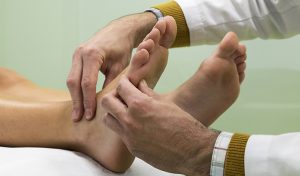Arthritis, a common condition affecting millions worldwide, can cause significant discomfort and limitations, especially when it affects the feet and ankles. As these joints bear the body’s weight and facilitate mobility, managing arthritis in this area is crucial for maintaining quality of life. In this comprehensive guide, we’ll explore arthritis treatment options for feet and ankles, the role of podiatrists and foot doctors, and essential steps to alleviate symptoms and improve mobility.
Understanding Arthritis in Feet and Ankles
Arthritis is a broad term encompassing various inflammatory conditions that affect the joints. In the feet and ankles, two types of arthritis are most prevalent: osteoarthritis and rheumatoid arthritis.
1: Osteoarthritis: This degenerative joint disease occurs when the protective cartilage that cushions the ends of bones wears down over time. As a result, bones may rub against each other, leading to pain, swelling, and stiffness in the affected joints.
2: Rheumatoid Arthritis: Unlike osteoarthritis, rheumatoid arthritis is an autoimmune disorder that causes the immune system to mistakenly attack the synovium—the lining of the joints. This inflammation can damage cartilage and bone, causing pain, swelling, and deformity in the feet and ankles.
Arthritis Treatment Options for Feet and Ankles
Managing arthritis in the feet and ankles requires a multi-faceted approach aimed at reducing pain, improving joint function, and slowing disease progression. Treatment options may include:
1: Medications: Nonsteroidal anti-inflammatory drugs (NSAIDs), corticosteroids, and disease-modifying antirheumatic drugs (DMARDs) are commonly prescribed to alleviate pain and inflammation associated with arthritis.
2: Orthotic Devices: Custom-made orthotic devices, such as shoe inserts or braces, can provide support, reduce pressure on affected joints, and improve foot alignment, thereby alleviating pain and enhancing mobility.
3: Physical Therapy: Targeted exercises and stretching routines prescribed by a physical therapist can help strengthen the muscles surrounding the affected joints, improve flexibility, and enhance joint stability.
4: Injection Therapies: Corticosteroid injections or hyaluronic acid injections may be administered directly into the affected joints to provide temporary relief from pain and inflammation.
5: Surgery: In severe cases of arthritis that do not respond to conservative treatments, surgical intervention may be necessary. Procedures such as joint fusion, joint replacement, or arthroscopic debridement can help alleviate pain and restore function in the feet and ankles.
Read More
The Role of Podiatrists and Foot Doctors
Podiatrists and foot doctors play a crucial role in diagnosing and managing arthritis in the feet and ankles. These healthcare professionals specialize in foot and ankle conditions and have expertise in identifying the underlying causes of arthritis-related symptoms. A podiatrist or foot doctor can provide personalized treatment plans tailored to the individual needs of each patient, incorporating a combination of conservative therapies and advanced interventions to optimize outcomes.
Essential Steps for Arthritis Management
In addition to seeking professional care from a podiatrist or foot doctor, individuals with arthritis in their feet and ankles can take several steps to manage their condition effectively:
1: Maintain a Healthy Weight: Excess weight can exacerbate arthritis symptoms by placing additional strain on the joints. Maintaining a healthy weight through diet and exercise can help reduce pressure on the feet and ankles, relieving pain and improving mobility.
2: Choose Supportive Footwear: Wearing supportive shoes with cushioned insoles and ample arch support can help reduce stress on the joints and minimize discomfort associated with arthritis. Avoid high heels or shoes with narrow toe boxes, as they can exacerbate foot pain and deformities.
3: Practice Gentle Exercise: Engaging in low-impact exercises such as swimming, cycling, or yoga can help improve joint flexibility, strengthen the surrounding muscles, and alleviate arthritis-related pain. Be sure to consult with a healthcare professional before starting any new exercise regimen.
4: Manage Stress: Stress can exacerbate inflammation and pain associated with arthritis. Practice stress-reducing techniques such as deep breathing, meditation, or mindfulness to promote relaxation and improve overall well-being.
Conclusion
Arthritis in the feet and ankles can significantly impact one’s quality of life, but with proper treatment and management, individuals can find relief from pain and improve mobility. By working closely with a podiatrist or foot doctor and implementing lifestyle modifications, individuals can take proactive steps towards managing their arthritis effectively and enjoying an active, pain-free lifestyle.
If you’re experiencing symptoms of arthritis in your feet and ankles, don’t hesitate to schedule an appointment with our expert podiatrist for personalized care and treatment tailored to your needs.




